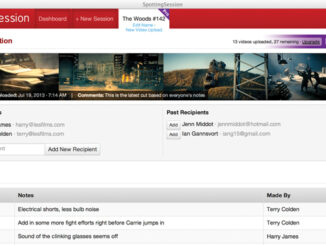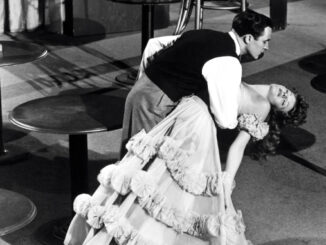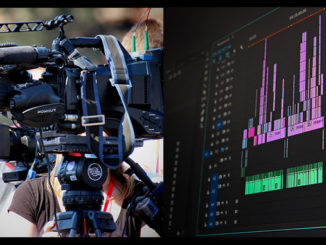
By Rob Feld
Growing up in North Dakota, Kayla Emter says she found her passion for editing not through movies, but through technology. At 16, she got an iMac with the iMovie app.
“Because there’s not much to do in North Dakota,” she said, “I found myself digging into it. I lost a whole afternoon working on a tutorial, shocked at how hooked I got. I recorded anything I could for the rest of high school, to have something to edit.” Emter went on to Columbia College in Chicago for film school and then to AFI, which led to opportunities in cutting rooms and a career.
Emter recently completed work with first-time feature director Eva Longoria on “Flamin’ Hot,” which is based on the true story of Richard Montañez (Jesse Garcia) who started as a kid in an East LA barrio community (Emter shares a credit with the other picture editor, Liza D. Espinas). To build a life for himself and his family, he landed a job as a Frito-Lay factory janitor and scored enough face time with PepsiCo CEO Roger Enrico to demonstrate how the company was ignoring the Mexican market in America. Montañez’s marketing ideas made Flamin’ Hot Cheetos a global pop culture phenomenon, and himself a successful executive.
The story is guided by Montañez’s first-person voiceover, which helps the film — which started streaming this month on Hulu and Disney+ — cover a lot of ground quickly, and with attitude. Voiceover can be a tricky tool, however, offering many pitfalls if used as a crutch. But “Flamin’ Hot” was not Emter’s first go-round with it as a storytelling device.
CineMontage: Tell me about what hooked you about editing, playing with that iMac?
Kayla Emter: I fell in love with editing because of the emotion it could evoke, and how much time you could spend on one thing, changing it with just the smallest shift of music. It felt like a superpower.
CineMontage: There are good ways to use voiceover and awful ways. In the first act of “Flamin’ Hot,” there’s a lot of ground to cover. What have you learned about using voiceover?
Kayla Emter: I’ve happened to work on a few voiceover movies and it’s a fine balance, but I love them when they’re done well. It’s a powerful tool and daunting because, while you get a set of scripted voiceover, it’s destined to change because the movie changes; the focus, the pace, the arrangement of scenes and connective tissue. You don’t want voiceover that is telling you what you’re seeing on the screen. It’s hard to find the right words to support the scene in a clever way, while feeling organic. There were a lot of modifications, partly because we rearranged some of the narrative structure. We started with Richard as a young child, moved into his rowdy days in the ’70’s, then his family life in the ’80’s, taking him into his job. When we rearranged everything, it needed new connective tissue and challenged us to figure out what we wanted to say in Richard’s voice about this moment. There was a lot of my voice in there for a while. I’m not a great writer, but I tried hard to put the intentions out there and then cringe while asking Eva, “What do you think?” We were always collaborating to find the voice of Richard while making sure there wasn’t too much. Then we’d go to the actor for a temp recording, knowing we’d have to go into the ADR booth and get the final recording. But from the words to that final recording, inflection changes, tone changes, performance changes. Every inflection and syllable matters. So, I like to work with the voiceover as much as I can when I’m editing to make sure it’s sitting in there and tonally matching what’s coming before and after. With this one, there’s a combination of final recordings and iPhone recordings that we begged our mixers to keep working on, to make them sound as full as the rest of it because performance wins. Voiceover’s a journey.
CineMontage: What is your part in working with the director to get that performance?
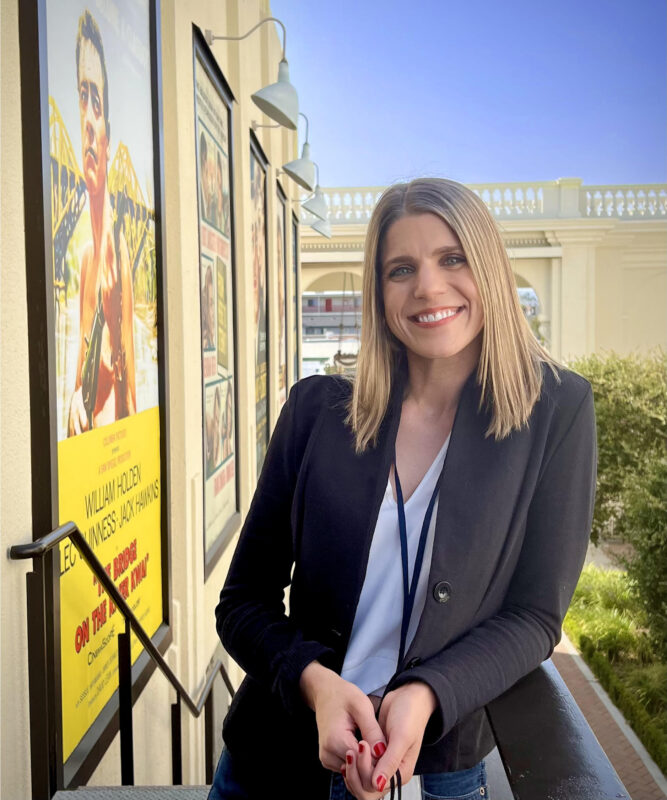
Kayla Emter: It starts with having that vision and that clear story that Eva wanted to tell about this man, his journey, where he is emotionally, and what he’s dealing with in his life at that time. And I think we were able to work together to find the right words. Eva was a great collaborator in that she’s clear about what she wants, then opens the door for those departments to offer their input and instincts. She often recenters you to what the vision is, but also lets great ideas shine as we improve on them. I’m not a director—I get nervous around actors in person because I feel like. I know you but you don’t know me. Jesse was great in the ADR booth but it takes a lot to get back into that character. You could read these lines in so many different ways. He balances being emotional and funny, but sometimes you would have to focus him. So even I would sit there and think, “What are we missing?” It was impressive to watch Eva work so well with actors to get that inflection while feeling like I had the opportunity to explain to her why I was looking for it.
CineMontage: Had you been present for ADR sessions on other projects?
Kayla Emter: Yes. It’s important and I love that part because it is where all of the temp elements come together, and it comes to life. I think an editor’s voice is important from the very beginning to the end. We have an intimate relationship with the movie and we know it on so many extra levels, that other departments that come in later don’t. So, I love being a part of ADR and I have lots of opinions, even though it’s the most nerve wracking for me and I try to hide in a corner. We were gifted a schedule on this one that also allowed me to be part of the mix and visual effects.
CineMontage: What was the great narrative challenge that led you to shift things around?
Kayla Emter: We found that you didn’t fully appreciate Richard’s hustle at the factory as he tries to make a name for himself, without knowing where he came from. That also went for his relationship with his wife, Judy (Annie Gonzalez). The movie really is a love story and it felt more sincere when you saw them bond as children from the top of the movie—they had each other’s backs. Seeing him at the factory meant more after seeing them struggle with two kids and not a lot of money, trying to find jobs, and knowing of Richard’s darker days of dealing drugs and getting into trouble. It made it a second chance that he didn’t squander and explained why he was so ambitious and determined. That’s where the restructure came from and why it was effective. So, even though it wasn’t intended to be told from beginning to end, which so many biopics are, it’s what was right for this one.
CineMontage: So, much was initially in flashback?
Kayla Emter: Yes. For example, he would say, “Judy and I have gone through a lot together. When we first met,” and we would cut to them as kids at school. But it mattered more to see it ahead of time. It connected you more with the characters.
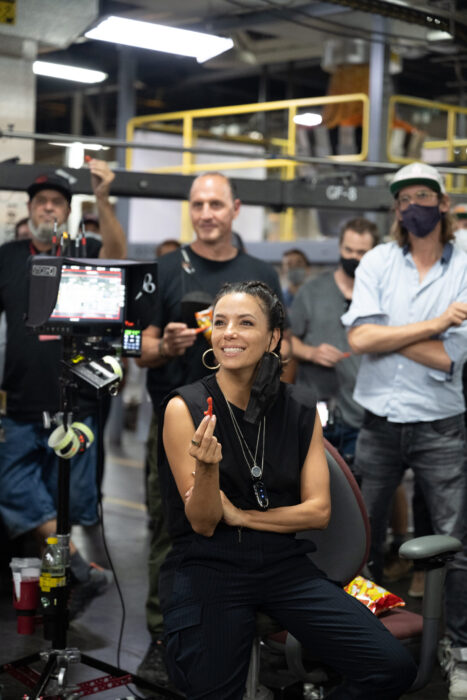
CineMontage: What was unique about this project for you?
Kayla Emter: My favorite part of this movie was that it allowed me to play. They handed me all the bells and whistles and said go for it, and find the balance. Playing with the sound design and collaborating with our sound designer, [Guild member] Katie Halliday, was a highlight for me—talking about the nuances of a whoosh versus a swoosh, or the personality of the machines in the factory. Our veteran factory worker hears the machines and knows from their rhythm when they’re working or not. We had to communicate that with sound in an organic way, so what does that sound like?
Being able to play with sound helps the pacing of a movie like this. I also got to work alongside the composer early on and talk about the emotion of the scenes. “This moment isn’t so triumphant, it’s more neutral and we need to build into this …” All of these departments were passionate about this story and Eva’s vision, just playing off of each other and inspiring each other to continue elevating the movie. So, by the time we got to the mix stage, we were all having a great time, seeing it all come to life. As an editor, this movie was special for being able to play, refine, and go too far, only to bring it back knowing it was too much. I felt very supported by our producers, which I don’t take lightly. It felt like we were all trying to make the best movie possible, and I think that comes through.



